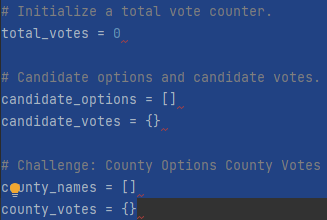Tom, a Colorado Board of Elections employee, requested my assistance in an election audit of the tabulated results of the U.S. Congressional precinct in Colorado. I was tasked with reporting the total number of votes cast, the total number of votes for each candidate, the percentage of votes for each candidate, the winner of the election based on the popular vote, the voter turnout for each county, the percentage of votes from each county of the total count and the county with the highest voter turnout. I used Python to automate the process and the resulting code could be used to audit not only other congressional districts but also senatorial districts and local elections.
The Election-Audit results were generated using Python code. See "PyPoll_Challenge.py" file. The results are as follows:
- Total votes cast in the election was 369,711.
- The county votes were as follows:
- Jefferson, 10.5% (38,855);
- Denver: 82.8% (306,055), and
- Arapahoe: 6.7% (24,801).
- The largest county turnout was Denver.
- Charles Casper Stockham received 85,213 votes or 23.0%.
- Diana DeGette received 272,892 votes or 73.8%.
- Raymon Anthony Doane received 11,606 votes or 3.1%.
- The election winner was Diana DeGette.
- Her winning vote count was 272,892.
- Her winning vote percentage was 73.8%.
We used a for loop in our code to loop through each row of the election_results.csv file and added a total vote counter and variables to count the votes from each county and from each candidate. See screenshot of code below.
We encountered a series of challenges in developing the code. This included not having the correct conditional statement. We found source code in GitHub from an earlier class student who dropped the "and" condition to determine the largest county turnout, resulting in the following code:
Tom and I successfully built and implemented Python code that automated an election audit, converting a manual Excel process into a repeatable process. I propose that the Election Commission authorize the use of our code to audit other congressional districts and senatorial districts and local elections. The code can be modified to be used for other elections. This would include changing the breakdown by counties to a breakdown required for senatorial districts and for local elections. This would also include changing the code to allow for the opening and reading of csv files that would contain the data for the other elections.

